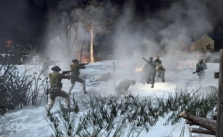Rising Storm 2 Vietnam Guide: 12 Tips to Get You Started
Get ready for intense, 64-player action in Rising Storm 2: Vietnam! In this thrilling game, players can choose their combat as either the South Vietnamese forces (including the US and their allies) or the North Vietnamese Army and National Liberation Front (also known as the Viet Cong). Whether you’re a seasoned veteran or new recruit, this guide is here to provide you with all the tips and tricks you need to succeed in Rising Storm 2: Vietnam. So gear up and let’s get started!
Use Suppressive Fire to Keep the Enemy at Bay
Suppressive fire is a tactic that involves firing your weapon in the direction of the enemy in order to keep them pinned down and prevent them from moving or attacking. This can be a very effective tactic in Rising Storm 2: Vietnam, as it allows you to control the battlefield and keep your opponents on the defensive. To use suppressive fire effectively, you will need to aim your weapon in the general direction of the enemy and fire in short bursts. This will keep them distracted and prevent them from focusing on you or your teammates.
Communicate with your team
Communication is key in any team-based game, and Rising Storm 2: Vietnam is no exception. Make sure to use your microphone or in-game chat to communicate with your teammates. Let them know your position, what you’re seeing, and any useful information you have about the enemy’s movements. This will allow your team to coordinate and work together more effectively, which can lead to better results in online matches.
Use cover effectively
Cover is an essential element in Rising Storm 2: Vietnam, as it provides protection from enemy fire and allows players to strategically position themselves on the battlefield. First and foremost, it’s important to understand the different types of cover available in the game. There are three main types: soft cover, hard cover, and partial cover. Soft cover is any surface that provides some protection from bullets, such as grass or bushes. Hard cover is a solid object that can fully block bullets, such as a wall or a tree. Partial cover is a surface that provides some protection from bullets but can still be penetrated, such as a fence or a window.
When using cover, it’s essential to consider the angle of your opponent’s fire. If an enemy is shooting at you from the side, it’s best to use hard cover that can fully block their bullets. If an enemy is shooting at you from above, it’s best to use partial cover that provides some protection but still allows you to see and shoot back at your opponent.
Another important factor to consider when using cover is the distance between you and your opponent. If you’re close to your enemy, it’s best to use cover that allows you to move quickly and take shots at them. If you’re farther away, you can use cover that provides more protection but may be more difficult to move around in.
Finally, it’s important to remember that cover is not a guarantee of safety. Your opponents can still shoot at you from different angles, such as from above or around the edges of your cover. It’s essential to constantly be aware of your surroundings and adjust your position accordingly.
In summary, effective use of cover in Rising Storm 2: Vietnam is essential for surviving on the battlefield. By understanding the different types of cover available and considering the angle and distance of your opponents’ fire, you can strategically position yourself to gain an advantage and emerge victorious in your matches.
Learn the maps
Each map in the game has its own unique layout and objectives. Familiarize yourself with the maps and learn the best routes and tactics for each one.
Do not Ignore Traps
Traps play a crucial role in providing players with an edge over their opponents. Proper use of traps can greatly impact the outcome of a battle.
Use traps to funnel enemies
By placing traps in strategic locations, you can force enemy players into a specific path or area. This can be especially useful when defending an objective, as it allows you to control the flow of enemy players and pick them off one by one.
Surprise your enemies
To effectively use traps in combat, consider setting them up in unexpected places. This can surprise your opponents and give you an advantage in a fight. A claymore mine is a useful trap for this purpose. These mines can be placed on walls or the ground, and they are activated by movement. When triggered, they release a burst of shrapnel in a wide arc. You can place a claymore mine in a room or behind a door where your enemies are likely to pass through.
Smoke grenades
Smoke grenades can be a powerful tool in Rising Storm 2: Vietnam, as they can obscure your enemies’ vision and provide cover for you and your team. Make sure to use them strategically, such as when you’re attacking an objective or trying to retreat from enemy fire.
Stay focused
The action in Rising Storm 2: Vietnam can be intense, so it’s important to stay focused and keep a clear head. Take breaks if needed to avoid getting overwhelmed.
Know your role
In Rising Storm 2: Vietnam, you can choose to play as a variety of different classes, each with its own unique abilities and roles. Make sure to choose a class that suits your playstyle and focus on fulfilling your role in the team.
- The rifleman is responsible for fighting and capturing objectives in combat.
- The scout or pointman is responsible for attacking the enemy on the front line, preferably in close-quarters combat.
- The machine gunner is responsible for defending objectives and providing suppression fire to allow other units to advance.
- The sniper or marksman is responsible for defending objectives and targeting enemies who are out of position.
- The sapper or combat engineer is responsible for destroying barricades and creating entry points for the team.
- The RPG or grenadier is responsible for clearing buildings and eliminating enemies hiding behind cover.
- The radioman is responsible for providing the commander with a radio to request support.
- The commander is responsible for leading the team.
- The combat pilot is responsible for providing air support for the team.
- The transport pilot is responsible for transporting teammates to landing zones for deployment.
Use the right weapon for the job
Each weapon in this game has its own strengths and weaknesses. Use the right weapon for the situation you’re in. For example, use a shotgun for close-range combat and a rifle for long-range combat.
Stay alive
Your primary goal in Rising Storm 2: Vietnam is to stay alive as long as possible. Try to avoid engaging in unnecessary firefights and focus on completing objectives and supporting your team.
Use the terrain to your advantage
Vietnam is a jungle-based game, and being stealthy can give you a big advantage. Stay hidden in the brush, take out enemy soldiers quietly, and use the terrain to your advantage.
Always stay with your squad
While it’s possible to play the game as a lone wolf, you’ll have a much better chance of success if you stick with your squad. Not only will you have more firepower at your disposal, but you’ll also be able to rely on your teammates for support and backup. Whether you’re attacking or defending, try to stay close to your squadmates and work together as a team.
Practice your aim
Finally, one of the most important tips for Rising Storm 2: Vietnam is to practice your aim. The better your aim is, the more likely you are to hit your targets and take out enemies. Make sure to spend some time practicing your aim in the game’s training mode, and try to aim for the head whenever possible for maximum damage.
We hope that our guide and tips for Rising Storm 2: Vietnam have been helpful in your journey through the game. Whether you’re fighting for the United States or the Viet Cong, remember to stay alert, work with your team, and use the strategies and tactics outlined in this guide to your advantage.
With practice and persistence, you’ll be able to master the battlefields of Vietnam and emerge as a true war hero. Good luck, and we’ll see you on the front lines!
















